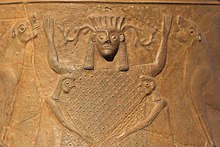

The Master of Animals, Lord of Animals, or Mistress of the Animals is a motif in ancient art showing a human between and grasping two confronted animals.[1] The motif is very widespread in the art of the Ancient Near East and Egypt. The figure may be female or male, it may be a column or a symbol, the animals may be realistic or fantastical, and the human figure may have animal elements such as horns, an animal upper body, an animal lower body, legs, or cloven feet. Although what the motif represented to the cultures that created the works probably varies greatly, unless shown with specific divine attributes, when male the figure is typically described as a hero by interpreters.[2]
The motif is so widespread and visually effective that many depictions probably were conceived as decoration with only a vague meaning attached to them.[3] The Master of Animals is the "favorite motif of Achaemenian official seals", but the figures in these cases should be understood as the king.[4]
The human figure may be standing, as found from the fourth millennium BC, or as kneeling on one knee found from the third millennium BC. They are usually shown looking frontally, but in Assyrian pieces typically they are shown from the side. Sometimes the animals are clearly alive, whether fairly passive and tamed, or still struggling, rampant, or attacking. In other pieces they may represent dead hunter's prey.[5]
Other associated representations show a figure controlling or "taming" a single animal, usually to the right of the figure. But the many representations of heroes or kings killing an animal are distinguished from these.[6]
- ^ Arruz, 303-304
- ^ Ross, Micah (ed), From the Banks of the Euphrates: Studies in Honor of Alice Louise Slotsky, pp. 174-177, 2008, Eisenbrauns, ISBN 1575061449, 9781575061443, Google books
- ^ Frankfort, 75
- ^ Teissier, Beatrice, Ancient Near Eastern Cylinder Seals from the Marcopolic Collection, p. 46, 1984, University of California Press, ISBN 0520049276, 9780520049277, google books
- ^ "Horse Cheekpiece" by "OWM", in Notable Acquisitions, 1980-1981, pp. 7-8, 1981, Metropolitan Museum of Art, ISBN 0870992848, 9780870992841, google books
- ^ Arruz, 308